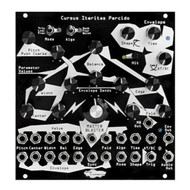Noise Engineering - Cursus Iteritas Percido
by Brandon Ivers
Before diving into the wonderfully weird Cursus Iteritas Percido [CIP], allow me to fess up to being a bit of a Noise Engineering fanboy. I love their Basilimus Iteritas Alter so much that I have two, and their overall approach to module design completely changed the way I thought about how to [re]build my modular. Their aesthetics are also right up my alley: overtly digital, cool black panels, and control over just about everything. As such, I was very excited to try the CIP and, in particular, the Master Blaster knob. But more on that in a bit...
At its core, the CIP is a complex wavetable oscillator. As is often the case in modular, it’s a lot more than “just” an oscillator, though, too. For one, the CIP includes a built-in AR envelope that can do everything from controlling the behavior of the modules’ internal VCA to controlling any of the myriad module parameters via the CIP’s envelope send knobs. Each bipolar envelope send can, in turn, be globally modulated via the excellently named Master Blaster knob. In other words, the CIP is already pre-patched to make a single envelope do a ton of different modulation. This routing makes the module very simple to use in a naive way, particularly for percussion patches. But should you want to get more complicated, almost everything, including the AR envelope itself, can be externally modulated.
The easiest way to get a sense of what the CIP is capable of is by patching a simple kick drum patch. Mult an external trigger to the Oscillator Sync and Trig inputs, and adjust the envelope sends so that you can get a bit of harmonic movement as the internal envelope progresses. Or keep it simple and just use the pitch envelope send. Either way, once you start playing with the envelope behavior and oscillator tune, the range of the module becomes immediately apparent: a standard kick can easily shift into woodblock sounds, atonal clangs, and acidic bass with minimal effort. Combine the fold parameter, and the CIP can get wonderfully squished and grimey, allowing for all sorts of industrial-sounding crunch.
I like starting with simple kick drum patches on the CIP because it’s so easy to expand out to building tom, snare, and bass patches as well. However, unlike many other complex oscillators, with the CIP, I found it more useful to think of building patches in terms of linear progression rather than layering. For example, there is no built-in noise oscillator on the CIP, which would usually limit your options for a snare patch. But what if you modulate the center, width, or edge parameters to create noise-like timbres that fade in or out over time? This is easy to do since the envelope sends are bipolar, so you can make the CIP’s single envelope work for transient bursts and decaying modulations. This approach to sound design is very much in the vein of additive synthesis, and it’s presented in a simple and fun way on the CIP.
Given all the modulation inputs, you aren’t limited to using the CIP’s internal envelope for everything, either. There’s modes like “loop” where the internal envelope turns into something akin to a granular window. I had a ton of fun with this mode in particular as it has a very distinctive, lo-fi sampler effect when using short envelope lengths. There’s also a free-running oscillator mode, so you can use the CIP as a more traditional oscillator as well, in turn allowing you to self-patch the internal envelope and/or combine external envelopes for more complex modulation. The CIP might appear to be opinionated at first, but the various modes available make it almost overwhelmingly flexible.
Speaking of the CIP’s various modes, there’s three wavetable algorithms you can select from as well: Daubechies, Fourier, and Walsh. If you want to bone up on your advanced mathematics, there’s plenty of info out there on each algorithm, but it’s probably more fun to just flip the switch around until it sounds cool.
I wouldn’t suggest the CIP to people looking for an analogue oscillator because, well, it isn’t one. I’m also not entirely sure I like the module’s stepped pitch tuning, though that’s a minor quibble. The CIP is a blast, it can fill in a lot of different roles, and it has a MASTER BLASTER knob [please, more macro controls like this!!]. Also, if you’re thinking about the CIP, I’d highly recommend looking at the Noise Engineering website for their manual and patchbook, both of which are excellent and do a wonderful job explaining how you might go beyond percussion patches and start writing fugues on this thing.
24 HP 60mA +12V 60mA -12V
Price: $595


